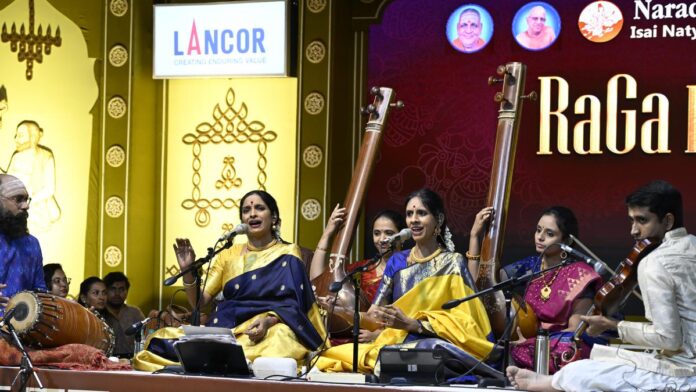
Ranjani and Gayatri Vittal Rangan (violin), K. Sai Giridhar (mridangam), and Anirudh Athreya (kanjira)
| Photo Credit: R. Ragu
When Ranjani and Gayatri present a concert a deep devotional fervour intertwines with melodic brilliance, resonating with the divine vision of the great composers. Their thematic recital ‘RaGa Bharatam’ at Narada Gana Sabha was no different. The impeccable synergy of the accompanying team comprising Vittal Rangan (violin), K. Sai Giridhar (mridangam), and Anirudh Athreya (kanjira) enhanced the concert’s appeal.
The core pieces of the recital — Tyagaraja’s ‘Evarimata vinnavo’ in Kamboji, dedicated to Lord Rama, and an RTP in Jonpuri as a tribute to the nation. Save for a medley at the end, the duo adhered to the traditional concert pattern, infusing it with a pan-Indian essence while creating a mosaic of cultural and linguistic heritage.
Dikshitar’s Natakurinji kriti ‘Parvathi kumaram’ and the kalpanaswaras lent a sparkling start. The fast phrases in the top octave highlighted Ranjani’s nuanced Lathangi essay. ‘Bharati deviya nene’, an ode by Purandaradasa to Hanuman’s mother Anjana, was an interesting choice, considering the resemblance of the song’s opening to the theme. The kriti was rendered with felicity, followed by gripping niraval and swara exchanges at ‘Sankara suravara vandita charane’ in the charanam.

The duo presented a well-curated concert
| Photo Credit:
R. Ragu
‘Kulirmathi vadane’, a Swati Tirunal padham in Malayala-manipravalam set to Dhanyasi in Misra Chapu by M. Jayachandran, ushered in an ethereal calm. In a classy Kamboji, Gayatri unfurled delightful phrases in the top octave. Vittal’s bow work was imbued with the raga’s sweetness. Every note in the leisurely kalpanaswaras at ‘Bhaktaparadhinudu’ brimmed with bhava. Interesting patterns and vibrant interplay marked the crisp tani by Sai Giridhar and Anirudh. Arunachala Kavi’s ‘Kanden kanden kanden seethaiyai’ in Vasantha served as a pace-setter ahead of the RTP.
Jonpuri, a melody that evokes a deep sense of yearning, was a fitting choice for the thematic pallavi. Ranjani and Gayatri alternated in unravelling its emotive hues. Vittal kept the reflective mood intact. The tanam was deftly presented in ascending speeds, culminating in the pallavi, a musical tribute by RaGa to Bharatam. ‘Kaalakaalamaay dharumam kaatha maanilame; raagabhavamaay potriduvom bhaaratame’, set to Khanda Triputa tala, featured a blend of chatusra and tisra nadais. It was an impassioned presentation by the siblings, with niraval and kalpanaswaras in two speeds. Ranjani’s swara passage in Saranga was followed by Gayatri’s in Sarasangi. The latter’s signature grahabedham effortlessly transitioned into Dharmavathi and Madhuvanthi.
The sisters evocatively depicted the dasya bhava (sense of subservience) to God. Nammazhwar’s pasuram ‘Appane adalaazhiyane’ was sung as a virutham in Mohanakalyani and Malayamarutham by Gayatri and Ranjani, respectively, followed by a Kannada verse ‘Ninna paduven ninna pogaluven’ by Gayatri in Kalyanavasantham, ahead of the Devaranama ‘Innu daya baarade’.
The grand final piece was a medley of four melodies in Desh, strung from as many languages — ‘Vande mataram’ extolling the nation (Sanskritised Bengali, Bankim Chandra Chatterjee), ‘Rama namame thudhi’ (Tamil, Thanjavur Sankara Iyer), ‘Hey govind hey gopal’ (Brij, Surdas), and ‘Tu hi sharan aayi’ (Marathi, Tukaram).
Published – January 01, 2025 06:10 pm IST
#Ranjani #Gayatris #concert #turns #musical #voyage
